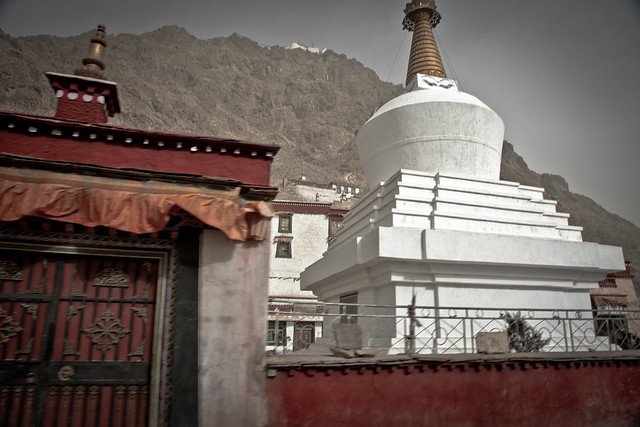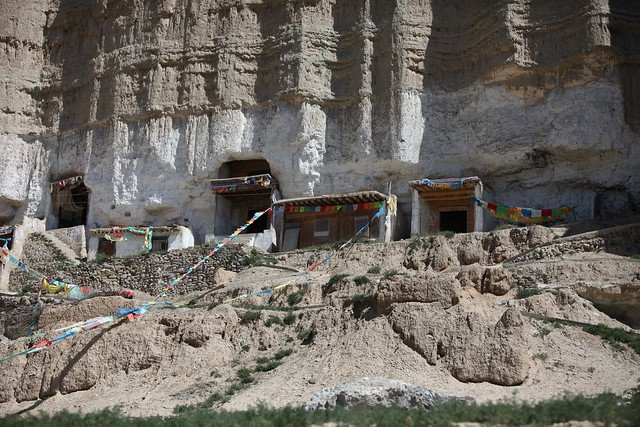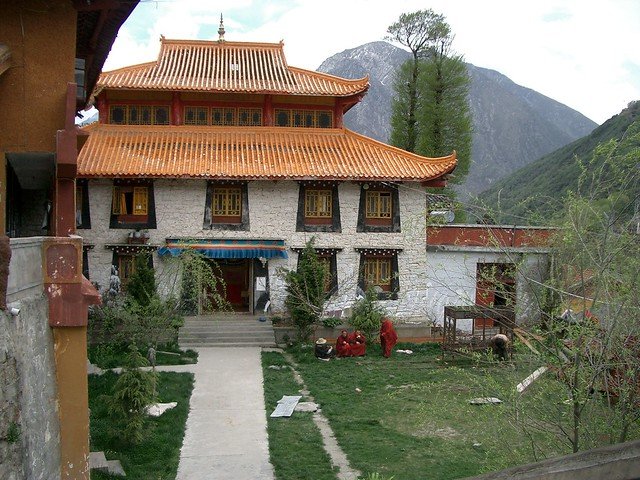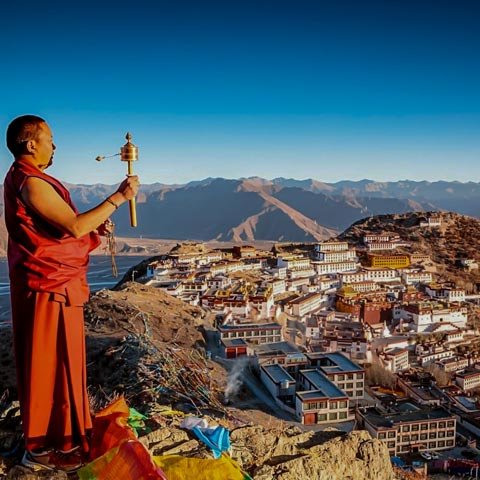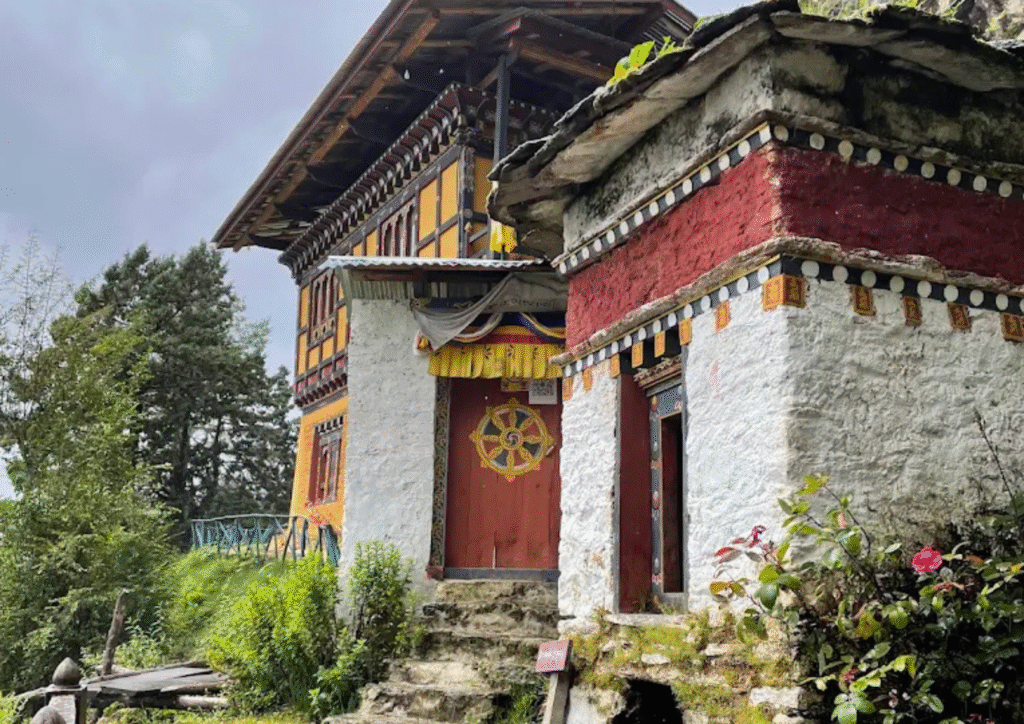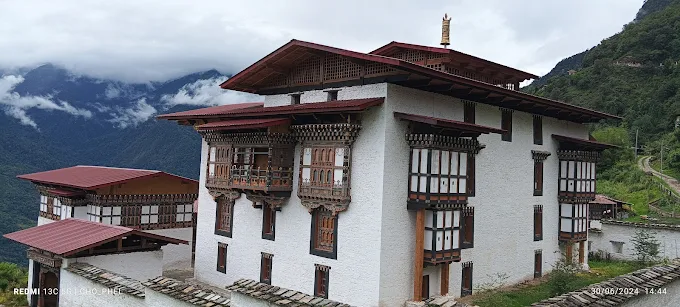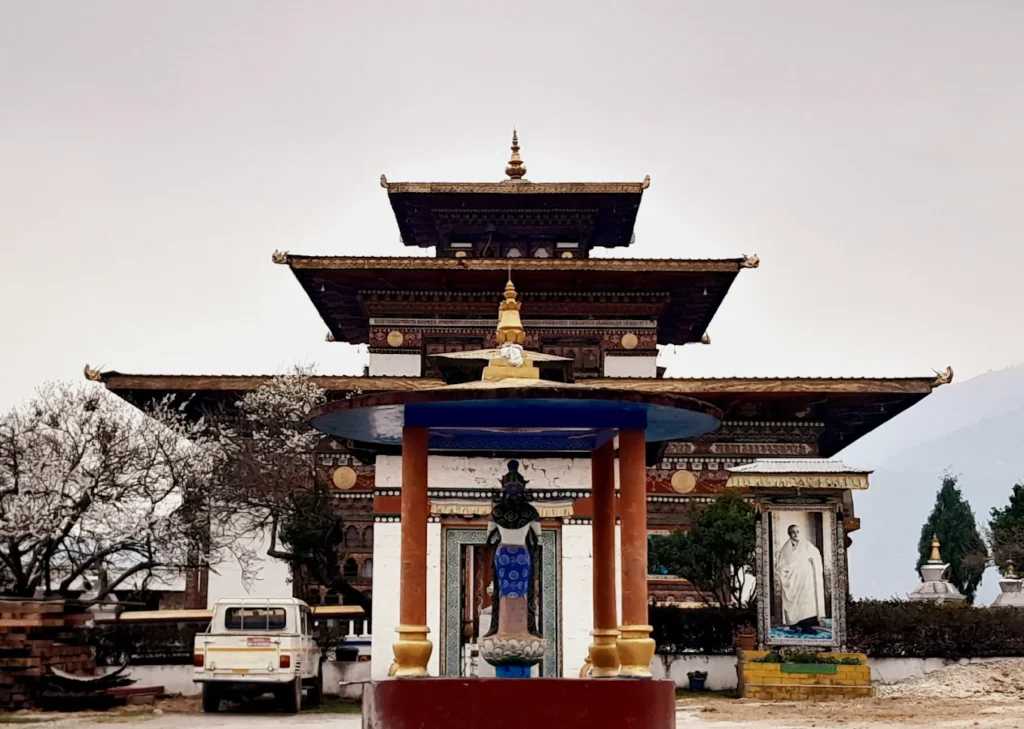Dorje Drak Monastery: The Thunderbolt Sanctuary of Nyingma’s Terma Legacy
Dorje Drak Monastery, nestled in a secluded enclave on the northern bank of the Yarlung Tsangpo River in Gonggar County, Tibet, shines as a sacred stronghold of the Nyingma sect, its ancient halls safeguarding the terma (hidden treasures) revealed by Rigdzin Godemchen. Founded in 1659 by Rigdzin Ngagi Wangpo, this revered gompa, one of the six major Nyingma monasteries, stands as a beacon of esoteric meditation and ritual mastery. At 3,600 meters, its whitewashed walls and golden spires glow beneath Zongyong Mountain’s vajra-shaped rock, captivating pilgrims and travelers with its mystical allure. This immersive listing unveils Dorje Drak’s essence, guiding you through its storied past, architectural serenity, sacred rituals, and practical visitor insights, offering a journey into a hidden gem of Tibetan Buddhism.
The Esoteric Heart of Dorje Drak
Essence of Dorje Drak Monastery
Dorje Drak Monastery radiates the profound wisdom of the Nyingma sect, embodying Tibet’s oldest Buddhist tradition through its devotion to terma revelations and Dzogchen meditation. Established in 1659, it ranks among the six mother monasteries of Nyingma, alongside luminaries like Samye and Mindrolling, revered for its spiritual potency. Its defining treasure—a self-arising Vajra (Dorje) relic, discovered by Rigdzin Godemchen—anchors its identity as the “Thunderbolt Rock” sanctuary. Hidden in the Yarlung Valley’s northern reaches, Dorje Drak’s remote tranquility invites deep reflection on Tibet’s spiritual heritage.
- Spiritual Core: Major Nyingma monastery, terma and Dzogchen focus.
- Iconic Feature: Self-arising Vajra relic, sacred terma.
- Cultural Role: Preserver of Nyingma esoteric traditions.
Historical Evolution
Dorje Drak’s legacy began in 1409 when Rigdzin Godemchen founded its original site in Tsang, revealing the Northern Treasure (Jangter) terma that enriched Nyingma practices. In 1659, Rigdzin Ngagi Wangpo, the third incarnation, relocated it to the Yarlung Valley, fulfilling a prophecy tied to a thunderbolt vision at Zongyong Mountain. The Cultural Revolution (1966–1976) razed its structures, leaving only ruins until restoration began in 1984 under the Fourth Dorje Drak Rigdzin. The monastery’s exile branch in Shimla, India, established in 1984, extends its global presence, preserving its teachings amidst diaspora communities.
- Founding: Original site in 1409, relocated in 1659.
- Terma Legacy: Godemchen’s 14th-century Northern Treasure.
- Restoration: Revived since 1984, Shimla branch in India.
Cultural Impact
Dorje Drak’s influence stems from its preservation of the Northern Treasure terma, shaping Nyingma rituals across Tibet, particularly in Kham and Amdo. Its texts, compiled by Godemchen, are studied via Treasury of Lives and HimalayanArt.org, influencing regional monasteries. Annual festivals, like the Vajrakilaya Drubchen, uphold Nyingma traditions, drawing local pilgrims. Globally, the Shimla branch and teachings by masters like Taklung Tsetrul Rinpoche connect Dorje Drak to international Nyingma communities, as noted in Dudjom Rinpoche’s The Nyingma School of Tibetan Buddhism.
- Terma Influence: Northern Treasure shapes Nyingma rites.
- Festival Traditions: Vajrakilaya Drubchen preserves heritage.
- Global Reach: Shimla branch, global Nyingma networks.
Signature Legacy
The self-arising Vajra relic, unearthed by Rigdzin Godemchen in the 14th century, is Dorje Drak’s crowning jewel, enshrined in the Tsuglhakhang and believed to radiate protective energy. A sacred Guru Rinpoche statue, revealed as a terma, anchors the monastery’s spiritual heart, its serene gaze captivating devotees. A legend recounts Godemchen’s vision of a thunderbolt striking Zongyong Mountain, naming the site “Dorje Drak” (Thunderbolt Rock) and affirming its sanctity. These relics define Dorje Drak’s mystical allure.
- Vajra Relic: Self-arising, protective terma.
- Guru Rinpoche Statue: Terma relic in Tsuglhakhang.
- Thunderbolt Vision: Founding legend of sanctity.
Community and Global Reach
Local Yarlung Valley residents cherish Dorje Drak, offering butter lamps during festivals and life events. Its 50 monks, primarily Nyingma, maintain rituals and guide pilgrims, fostering spiritual continuity. The Tibetan diaspora connects through the Shimla branch, while international tourists, drawn by Tibet Travel and Rigpa Wiki, seek its remote sanctity. Social media posts on X and academic studies amplify its influence, linking Dorje Drak to global Buddhist networks.
- Local Devotion: Butter lamp offerings by Yarlung residents.
- Monastic Community: 50 Nyingma monks guide pilgrims.
- Global Appeal: Shimla branch, tourists, scholars.
Architectural Serenity of Dorje Drak
Distinctive Design
Dorje Drak’s architecture, spanning 5,000 square meters at 3,600 meters, blends traditional Tibetan simplicity with Nyingma spiritual symbolism, its whitewashed walls and golden spires nestled beneath Zongyong Mountain’s vajra-shaped rock. Centered on the Tsuglhakhang (main hall), it features a courtyard with chortens and prayer wheels, reflecting 17th-century gompa styles. The fortress-like layout, designed for seclusion, contrasts with the Yarlung Valley’s lush fields, creating a serene aesthetic unique to Dorje Drak’s remote setting.
- Style: Traditional Tibetan, Nyingma symbolism.
- Layout: Tsuglhakhang, courtyard, chortens.
- Setting: White walls under Zongyong Mountain.
Signature Structures
The Tsuglhakhang, a single-story hall restored in 1984, enshrines the self-arising Vajra relic and Guru Rinpoche statue, adorned with thangkas of Northern Treasure deities. The Vajrakilaya Lhakhang, a side chapel, houses a wrathful deity statue central to annual rituals. The outer kora path, lined with 108 prayer wheels, encircles a small chorten commemorating Godemchen’s terma discovery. A nearby meditation cave, used by Rigdzin Ngagi Wangpo, adds esoteric depth, drawing retreat practitioners.
- Tsuglhakhang: Vajra relic, Guru Rinpoche statue.
- Vajrakilaya Lhakhang: Wrathful deity statue.
- Meditation Cave: Ngagi Wangpo’s retreat site.
Artisanal Mastery
Dorje Drak’s thangkas, crafted by monks, depict Nyingma deities like Vajrakilaya with mineral pigments, their hues vibrant post-1984 restoration. The Guru Rinpoche statue, a 17th-century terma relic, showcases clay sculptural finesse, while the Vajra relic, naturally formed, is a sculptural marvel. Carved wooden beams, featuring lotus motifs, adorn the Tsuglhakhang, and silk thangkas of Godemchen hang in chapels. These works, preserved through restoration, highlight Dorje Drak’s artistic legacy.
- Thangkas: Nyingma deities, vibrant pigments.
- Guru Rinpoche Statue: 17th-century terma relic.
- Wood Carvings: Lotus-motif beams, silk thangkas.
Hidden Architectural Gems
Dorje Drak conceals subtle treasures within its modest grounds. The kora path’s upper ledge offers intimate views of the Yarlung Tsangpo River, framed by prayer flags fluttering in the breeze. A faded mural in the Vajrakilaya Lhakhang depicts Godemchen’s terma discovery, offering a historical glimpse. The courtyard’s mani stone pile, etched with Om Mani Padme Hum, invites quiet reflection, while a small shrine near the cave holds a self-arising mani stone, believed to bless pilgrims.
- Kora Ledge: Yarlung River views.
- Terma Mural: Godemchen artwork in Lhakhang.
- Mani Stone Pile: Mantra-etched courtyard stones.
Preservation and Evolution
Preserving Dorje Drak’s structures is challenging due to Tibet’s harsh climate and remote location. Restoration since 1984, funded by local devotees and exile donations via the Shimla branch, used traditional pigments for thangkas and reinforced mud-brick walls. The Tsuglhakhang’s roof was regilded in 1990, blending modern durability with 17th-century aesthetics. Ongoing efforts ensure Dorje Drak’s legacy endures, despite erosion and limited resources.
- Restoration: Pigments, wall reinforcements since 1984.
- Gilded Roof: Regilded in 1990.
- Funding: Local, exile devotees.
Sacred Rites and Nyingma Mysticism
Sacred Daily Rites
Each dawn, Dorje Drak awakens with resonant chants, as monks gather in the Tsuglhakhang, their voices harmonizing with butter lamp glow. Pilgrims offer khatas (silk scarves) at the Guru Rinpoche statue, their prayers mingling with juniper incense. The hum of 108 prayer wheels along the kora path creates a meditative rhythm, enveloping visitors in Dorje Drak’s spiritual calm.
- Chanting: Morning sutras in Tsuglhakhang.
- Offerings: Khatas at Guru Rinpoche statue.
- Ambiance: Incense, prayer wheel hum.
Unique Spiritual Practices
Dorje Drak’s monks perform Nyingma rituals, including Vajrakilaya empowerments and Dzogchen meditations, rooted in the Northern Treasure tradition. Pilgrims walk the kora, spinning prayer wheels to accrue merit, a practice tied to Godemchen’s terma revelations. The Vajra relic chapel hosts rare blessing ceremonies, where monks invoke protective energies, unique to Dorje Drak’s esoteric legacy. These rituals, steeped in 14th-century terma, deepen the monastery’s spiritual allure.
- Vajrakilaya Rites: Northern Treasure empowerments.
- Kora: 108 prayer wheel circumambulation.
- Vajra Blessings: Protective relic ceremonies.
Vibrant Festival Traditions
Dorje Drak’s festivals transform the monastery into a vibrant devotional hub. The Vajrakilaya Drubchen, held in the eighth lunar month, features seven-day tantric rituals and Cham dances depicting wrathful deities, drawing local pilgrims. Saka Dawa, commemorating Buddha’s enlightenment, includes kora walks, lamp offerings, and mass prayers. Sharing tsampa (roasted barley) and butter tea unites locals, reinforcing Dorje Drak’s role as a spiritual anchor.
- Vajrakilaya Drubchen: Seven-day tantric rites, Cham dances.
- Saka Dawa: Kora, lamp offerings, prayers.
- Community Role: Tsampa, tea shared.
Visitor Engagement
Visitors can offer khatas or light butter lamps at the Guru Rinpoche statue, guided by monks, immersing themselves in Dorje Drak’s spiritual life. Photography is permitted in most areas for a small fee (10 yuan), capturing thangkas’ vivid details, but flash is prohibited, and the Vajra relic chapel bans photos. Joining the kora allows travelers to walk with pilgrims, feeling Dorje Drak’s sacred rhythm. Monks may share tales of Godemchen’s terma visions, enriching the experience.
- Offerings: Khatas, lamps with monk guidance.
- Photography: 10-yuan fee, no flash, no Vajra chapel photos.
- Kora Participation: Walk with pilgrims.
Monastic and Community Roles
Dorje Drak’s 50 monks, primarily Nyingma, maintain daily rites, study Northern Treasure texts, and guide visitors, upholding its esoteric legacy. They offer blessings for local harvests, weddings, and life events, strengthening Yarlung Valley ties. The monastery trains young monks in thangka painting and ritual dance, preserving Nyingma artistry. This bond ensures Dorje Drak remains a living spiritual center, fostering devotion and continuity.
- Monastic Duties: Rites, study, visitor guidance.
- Community Ties: Blessings for local events.
- Art Preservation: Thangka, dance training.
Visiting Dorje Drak Monastery
Navigating to Dorje Drak Monastery
Dorje Drak lies in Changguo Township, Gonggar County, Shannan Prefecture, approximately 18 km east of the Gālá Shān tunnel (leading to Gonggar Airport) and 50 km west of Samye Monastery, on the northern bank of the Yarlung Tsangpo River. From Lhasa, a 120–130-km drive via the G318 highway takes 2.5–3 hours by private tour vehicle, passing Tsedang (70 km east). From Tsedang, a 1-hour taxi or hired vehicle along a rural road west reaches the monastery, marked by its white walls beneath Zongyong Mountain. The nearby Samye Monastery (50 km east) or Gonggar Dzong ruins serve as guiding landmarks.
- From Lhasa: 2.5–3-hour drive, 120–130 km via Tsedang.
- From Tsedang: 1-hour taxi, 70 km west.
- Local Access: Rural road from Tsedang, near Zongyong Mountain.
Address of Dorje Drak Monastery
- Location: Changguo Township, Gonggar County, Shannan Prefecture, Tibet Autonomous Region, China.
- Coordinates: 29.3167° N, 91.0667° E (approximate).
- Context: Northern bank of Yarlung Tsangpo, 18 km east of Gālá Shān tunnel.
Visiting Hours and Etiquette
Dorje Drak is open daily from 9:00 AM to 5:00 PM, with early visits recommended due to its remote setting and limited facilities. Dress modestly, covering shoulders and knees, and remove hats in chapels to show respect. Photography is allowed in most areas for a 10-yuan fee; bring a flashlight for dim interiors, avoid flash, and note that the Vajra relic chapel prohibits photos. Respect pilgrims by maintaining silence and not touching relics or statues.
- Hours: 9:00 AM–5:00 PM, best in morning.
- Dress Code: Modest clothing, no hats in chapels.
- Etiquette: 10-yuan photo fee, no flash, no Vajra chapel photos.
Accessibility and Safety
Dorje Drak’s grounds are accessible via unpaved rural paths, but the Tsuglhakhang and chapels feature low doorways and steps, posing challenges for those with mobility issues. Wheelchair users require assistance due to rough terrain; arrange with tour operators in advance. The 3,600-meter altitude requires acclimatization to avoid sickness; hydrate and rest frequently. The remote setting is safe, but watch for stray dogs and carry cash for fees, as no ATMs or shops are nearby.
- Accessibility: Unpaved paths, low doorways, steps.
- Mobility Aids: Limited, arrange assistance.
- Safety: Acclimatize, watch for dogs, carry cash.
Amenities and Surroundings
Dorje Drak offers no restrooms, shops, or dining facilities; bring water, snacks, and essentials. Tsedang’s markets, 70 km away, offer momos (dumplings), butter tea, and yak-meat noodles, immersing visitors in local flavors. The monastery’s courtyard, adorned with prayer flags and chortens, provides serene spots for reflection. The Yarlung Valley’s cliffs, Zongyong Mountain’s vajra rock, and nearby Gonggar Dzong ruins offer scenic exploration, enriching the visit.
- Amenities: None on-site, bring essentials.
- Food: Tsedang markets with momos, tea.
- Surroundings: Courtyard, Yarlung Valley, Gonggar Dzong.
Immersive Visitor Tips
Arrive at dawn to hear monks chanting in the Tsuglhakhang, their voices resonating through the hall, creating a meditative atmosphere. Photograph the chortens from the kora’s upper ledge at midday, capturing their contrast against Zongyong Mountain, paying the 10-yuan fee and avoiding flash. Visit the meditation cave at dusk, when the valley’s cliffs glow golden, enhancing Dorje Drak’s mystical ambiance. Savor butter tea in Tsedang’s markets, chatting with locals about Godemchen’s terma visions for cultural insights.
- Dawn Visits: Hear chants in Tsuglhakhang.
- Photography: Kora ledge chorten shots, 10-yuan fee, no flash.
- Evening Cave Visit: Cliff views at dusk.
